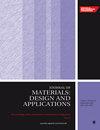Experimental and numerical analysis of ballistic impat and material characterization of GFRP and Kevlar 29/epoxy composite laminate
IF 2.2
4区 材料科学
Q3 MATERIALS SCIENCE, MULTIDISCIPLINARY
Proceedings of the Institution of Mechanical Engineers, Part L: Journal of Materials: Design and Applications
Pub Date : 2024-09-09
DOI:10.1177/14644207241269584
引用次数: 0
Abstract
Through experimental testing and numerical simulations, this study examines the effects of ballistic events on thin FRP composite laminated plates fabricated using a hand lay-up method. Experimental ballistic impact tests using a pneumatic gun are conducted on composite plates reinforced with woven glass and woven Kevlar 29 fibers. An advanced three-dimensional finite element model programed in Ansys/Autodyn v19.1 is employed to verify the experimental findings and analyze the ballistic perforation characteristics of the target. The crucial material constants needed for the constitutive material model used in the simulation are acquired through precise experimentation on samples prepared from the fabricated laminates. Significant agreement is observed between the FE simulations and experimental findings, particularly concerning the assessment of residual velocities of the projectile and damage pattern in the laminates. The results of this study show that when subjected to ballistic impact by a flat-ended cylindrical projectile, the thin woven FRP composite primarily experiences damage characterized by delamination, fiber breakage and matrix cracking. Additionally, based on current simulations, it is observed that the ballistic limit velocity of the Kevlar 29/epoxy laminate exceeds that of GFRP by 25.64% when both materials have an equal thickness of 2.8 mm.GFRP 和 Kevlar 29/epoxy 复合材料层压板弹道 Impat 和材料特性的实验和数值分析
本研究通过实验测试和数值模拟,考察了弹道事件对采用手糊法制造的玻璃钢复合材料薄层板的影响。使用气动枪对编织玻璃纤维和编织 Kevlar 29 纤维增强的复合板进行了实验性弹道冲击测试。使用 Ansys/Autodyn v19.1 编制的先进三维有限元模型验证了实验结果,并分析了目标的弹道穿孔特性。模拟中使用的材料构成模型所需的关键材料常数是通过对制造的层压板样品进行精确实验获得的。在有限元模拟和实验结果之间发现了显著的一致性,特别是在评估弹丸的残余速度和层压板的损坏模式方面。研究结果表明,当受到平头圆柱形弹丸的弹道冲击时,薄编织玻璃钢复合材料主要会出现分层、纤维断裂和基质开裂等损伤。此外,根据目前的模拟观察,当 Kevlar 29/epoxy 复合材料的厚度均为 2.8 毫米时,其弹道极限速度比 GFRP 高出 25.64%。
本文章由计算机程序翻译,如有差异,请以英文原文为准。
求助全文
约1分钟内获得全文
求助全文
来源期刊

CiteScore
4.70
自引率
8.30%
发文量
166
审稿时长
3 months
期刊介绍:
The Journal of Materials: Design and Applications covers the usage and design of materials for application in an engineering context. The materials covered include metals, ceramics, and composites, as well as engineering polymers.
"The Journal of Materials Design and Applications is dedicated to publishing papers of the highest quality, in a timely fashion, covering a variety of important areas in materials technology. The Journal''s publishers have a wealth of publishing expertise and ensure that authors are given exemplary service. Every attention is given to publishing the papers as quickly as possible. The Journal has an excellent international reputation, with a corresponding international Editorial Board from a large number of different materials areas and disciplines advising the Editor." Professor Bill Banks - University of Strathclyde, UK
This journal is a member of the Committee on Publication Ethics (COPE).
 求助内容:
求助内容: 应助结果提醒方式:
应助结果提醒方式:


